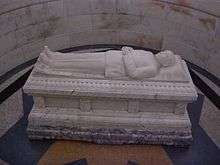Gisant



A gisant (French, “recumbent”) is a recumbent effigy on a tomb depicting a prominent deceased person in the process of dying or as a corpse.[1] Such compositions, developed in western Europe in late medieval, Renaissance, and early moderns times, may represent the deceased in a state of “eternal repose”, hands folded in prayer and awaiting resurrection. A husband and wife may be depicted together. An important official or leader may be shown holding his attributes of office or dressed in the formal attire of his official status or social class.
Some of the best-known examples of the form are in Westminster Abbey in London, Saint Peter's in Rome, Santi Giovanni e Paolo, Venice (twenty-five Doges), and the Basilica of Santa Croce, Florence.
A celebrated poem describing and reflecting on a stone effigy is An Arundel Tomb by Philip Larkin.
History
Ancient precursors
Recumbent effigies were a common tradition in Etruscan funerary art, examples are known in both ceramic and stone. The deceased was typically depicted alive as at a feast, lying sideways, propped up on one arm and sometimes holding a cup. Usually these were rather smaller than life-size. The Romans continued this tradition, though they also created many other types of funerary effigy. Their faces are often clearly portraits of individuals.
Medieval
The first medieval gisants emerged in the 12th century. They were executed in low relief, and were horizontal, but appeared as in life. The faces were generalized rather than portraits. Gradually these became full high-relief effigies, usually recumbent, as in death, and, by the 14th century, with hands together in prayer. In general, such monumental effigies were carved in stone, marble or wood, or cast in bronze or brass. Often the stone effigies were painted to simulate life, but in the majority of the medieval monuments, this has long since disappeared. The crossed-legged attitude of numerous mail-clad, knight-like gisants was long supposed to imply that the deceased had served in the Crusades, but this supposition is unfounded. By the early 13th century, the gisants began to be raised on tomb-style chests (known as tomb chests or altar tombs) decorated with foliage, heraldry or architectural detailing. Soon such chests also stood alone with varying degrees of decoration. By the end of the century, these often had architectural canopies and figured "weepers" or "mourners" — representing friends or relatives and identified by their coats of arms — were popular decorative features.
Another late medieval fashion was to show the person in an advanced state of decomposition, perhaps as a secondary effigy. This type of tomb is known as a transi.
Later
During the Renaissance, other non-recumbent types of effigy became more popular. Variations showed the deceased lying on their side as if reading, kneeling in prayer and even standing. The gisant had something of a vogue during the Gothic revival period of the 19th century. Many graves at Monument Cemetery in Milan have gisant figures.
A late example of a stone effigy is that of T.E.Lawrence ('Lawrence of Arabia') by Eric Kennington, in St Martin's Church, Wareham, in Dorset.
Variants
- A particular type of gisant was the transi, or cadaver tomb, in which the effigy is in the macabre form of a decomposing corpse.
References
- ↑ Lucie-Smith, Edward (1984), The Thames and Hudson Dictionary of Art Terms, Thames and Hudson, pg 89.
| Wikimedia Commons has media related to effigies. |
